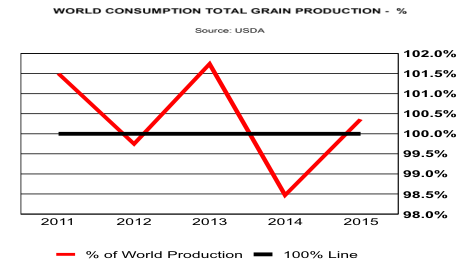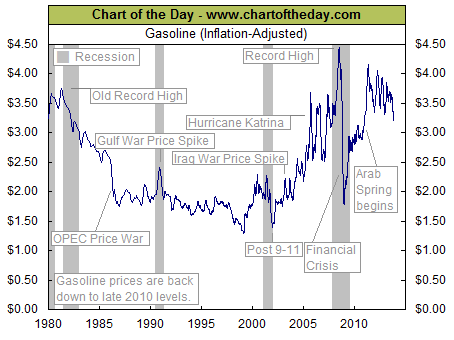Energy & Commodities
Grow It, and They Will Eat It.
“Build it, and they will come” has been the motivation for many dreams. Baseball fields, restaurants, and other follies have sprouted from belief in this concept. Much of the real estate industry of times now past lived by this philosophy. That worked until they did not come, and then the bankers came for the remains.
In Agri-Food we have a similar motto: Grow it, and they will east it. We worry little about relying on such a belief, for people eating is, unlike baseball, not optional. That the world will eat it if it is grown can be observed in the following chart.

Note on chart: USDA works in crop years, not calendar years. At present we are in crop year 2014. That year runs from September 2013 through the end of August 2014. The current Northern Hemisphere harvest in process, which includes that now concluding in the U.S., is part of the data point for 2014 in the graph.
Plotted in the chart is percentage of the world’s total grain production that is consumed. That ratio is expressed as a percentage, and uses the right vertical axis. A solid black line highlights the 100% level which means that all of the world’s grain production is being consumed.
In the first three years plotted in the graph the world’s consumption of total grains produced averaged more than 100%. Essentially, over that period the world consumed all the grains produced plus some of that which had been stored from previous years. The value for 2013, the highest in the chart, is due in part to the drought which dramatically reduced U.S. grain production in the Fall of 2012.
…read more HERE

Today’s chart provides some long-term perspective in regards to gasoline prices by presenting the inflation-adjusted US price of one gallon of gasoline since 1980. There are a couple points of interest from today’s chart. For one, Middle East crises are often associated with major swings in the price of gasoline. Also, gasoline price spikes have often occurred prior to an economic downturn. It is also worth noting that gasoline prices have declined $0.65 per gallon over the past eight months — a relative positive for both the economy and corporate earnings going forward.

Quote of the Day
“To keep a lamp burning we have to keep putting oil in it.” – Mother Teresa
Events of the Day
November 27, 2013 – Hanukkah (1st day)
Stocks of the Day
— Find out which stocks investors are focused on with the most active stocks today.
— Which stocks are making big money? Find out with the biggest stock gainers today.
— What are the largest companies? Find out with the largest companies by market cap.
— Which stocks are the biggest dividend payers? Find out with the highest dividend paying stocks.
— You can also quickly review the performance, dividend yield and market capitalization for each of the Dow Jones Industrial Average Companies as well as for each of the S&P 500 Companies.
Chart of the Day is FREE to anyone who subscribes just subscibe HERE Chart of the Day
Notes:
Where should you invest? The answer may surprise you. Find out right now with the exclusive & Barron’s recommended charts of Chart of the Day Plus.

Copper prices will not suffer significantly from a moderate global surplus next year, the chief executive officer of the world’s No. 1 producer of the metal told Reuters on Tuesday.
“We’re expecting that we’ll surely have a small metal surplus, but at relatively modest levels,” Thomas Keller, CEO of Chile’s Codelco, said at the Ministro Hales mine project near the city of Calama in the nation’s mineral-rich north.
World demand for the red metal has exceeded supply since the global financial crisis, but increased output from new and existing mines has been expected to reverse that trend from 2013.
Analysts expect the global copper market to post a surplus of 182,000 tonnes this year, up from a previous forecast of 153,000 tonnes, and then balloon to 328,000 tonnes in 2014, according to a Reuters poll last month.
Copper has traded at $7,000 to $7,420 a tonne since early August, held back by swelling supply and slower demand growth in China.
“Prices are moving in a range that is to be expected given the market conditions,” Keller said.
Codelco is in the midst of an ambitious investment plan to boost output in its massive but tired mines. The company’s production in 2012 fell to its lowest since 2008, although it was more stable in the first half of this year.
Keller has said Codelco expects output for 2013 as a whole to come in slightly ahead of last year, when it produced roughly 1.65 million tonnes, excluding the El Abra and Anglo American Sur operations.

WHOLESALE GOLD bumped up to $1285 Tuesday lunchtime in London, reversing an overnight drop to fresh 3-week lows at $1277 as European stock markets slipped with government bond prices.
“A slip through the six-month support line at $1270.16 will confirm our bearish outlook,” says Commerzbank’s Axel Rudolph.
“We could potentially,” says French bank Natixis’ precious metals analyst Bernard Dahdah, “see gold prices reach levels of $850 to $1,000. But this is our very low-case scenario.”
Gold prices that low could unleash a wave of forward selling by mining companies, says French investment bank BNP Paribas, with miners trying to lock in current prices for fear of further falls ahead.
“Producers, the share prices of which have not been faring well of late,” BNP’s commodity team notes, “might initiate and/or accelerate hedging were we to approach the symbolic $1000 level, adding supply to the market and further downward pressure to prices.”
Were gold to fall below that price, investment author and hedge-fund manager Jim Rogers told India’s ET Now TV last week, “I hope I’m smart enough to buy a lot more.”
Explaining why he’s not buying gold right now, “It went up 12 years in a row, which is highly unusual for any asset,” says Rogers. “And of course, India’s doing its best to kill the gold market.”
This month’s Diwali festival saw gold buying drop by more than one-third from 2012, according to retail dealers, thanks to the lack of supply caused by the Indian government’s anti-gold import rules.
Even with gold falling a further 3% in the wholesale bullion markets for November so far, “There’s little sign yet of a boost in physical demand,” says one Asian dealing desk.
“Gold is clearly lacking bullish conviction,” says another.
“With equities performing well,” agrees Scotiabank’s latest Metals Matters monthly, “and with the global economy looking more stable, investment demand for gold may well remain subdued.
“That could keep the lid on prices.”
Confidence levels amongst UK private investors rose in October for the third month running, says a survey from retail stockbrokers Hargreaves Lansdown, reaching a nine-year high with 8 in 10 respondents saying the stock market will rise again in 2014.
Market professionals have also “fallen into a state of relative complacency,” says bond-fund giant Pimco’s CEO Mohamed El-Erian, “comforted by the notion of a ‘central-bank put’.
“The result is financial risk-taking that exceeds what would be warranted strictly by underlying fundamentals.”
Contrasting with last week’s strong GDP and new jobs figures, the National Federation of Independent Businesses said Tuesday that its optimism index dropped 2.3 points to 91.6 last month, primarily due to the government shutdown.
Gold for UK investors had earlier turned higher from its 3rd dip below £800 per ounce this year as the British Pound sank on news of much weaker than expected consumer price inflation.
The news comes after strong GDP and other data raised expectations that the Bank of England could soon raise UK interest rates from their all-time low at 0.5%.
Adrian Ash
Gold price chart, no delay | Buy gold online
Adrian Ash is head of research at BullionVault, the secure, low-cost gold and silver market for private investors online, where you can fully allocated bullion already vaulted in your choice of London, New York, Singapore, Toronto or Zurich for just 0.5% commission.
Please Note: This article is to inform your thinking, not lead it. Only you can decide the best place for your money, and any decision you make will put your money at risk. Information or data included here may have already been overtaken by events – and must be verified elsewhere – should you choose to act on it.

 Proving that idiocy truly has no bounds, Spain issued a “royal decree” taxing sunlight gatherers. The state threatens fines as much as 30 million euros for those who illegally gather sunlight without paying a tax.
Proving that idiocy truly has no bounds, Spain issued a “royal decree” taxing sunlight gatherers. The state threatens fines as much as 30 million euros for those who illegally gather sunlight without paying a tax.
The tax is just enough to make sure that homeowners cannot gather and store solar energy cheaper than state-sponsored providers.
Via Mish-modified Google Translate from Energias Renovables, please consider Photovoltaic Sector, Stunned
The Secretary of State for Energy, Alberto Nadal, signed a draft royal decree in which consumption taxes are levied on those who want to start solar power systems on their rooftops. The tax, labeled a “backup toll” is high enough to ensure that it will be cheaper to keep buying energy from current providers.
Spain Privatizes the Sun
Via Google translate from El Pais, please consider Spain Privatizes The Sun
If you get caught collecting photons of sunlight for your own use, you can be fined as much as 30 million euros.
If you were thinking the best energy option was to buy some solar panels that were down 80% in price, you can forget about it.
“Of all the possible scenarios, this is the worst,” said José Donoso, president of the Spanish Photovoltaic Union (UNEF), which represents 85% of the sector’s activity.
Before the decree it took 12 years to recover the investment in a residential installation of 2.4 kilowatts of power. Following the decree, it will take an additional 23 years according to estimates by UNEF.
Petition of the Candle Makers Revisited
And so the “Petition of the Candle Makers” comes to pass.
I have written about the “petition” on many occasions, but here is the latest reference: Extremely Difficult to Keep Up With Economic Stupidity
Reflections on “Unfair Competition”
Corporations always consider it “unfair” when any other company can do things faster, smarter, or cheaper than they can. The buggy whip industry once protested cars.
Today, land-line telecom companies have to compete with wireless and they don’t like it. Now, we see protests about VOIP (voice over internet protocol).
Technology marches on. But France does not like it. The French solution is to tax Skype because it has an “unfair advantage“.
This is an age-old unwinnable argument.
Petition of the Candle Makers
The ultimate irony is France’s preposterous “unfair advantage” argument was lampooned by French economist Frederic Bastiat back in 1845 when he penned ‘Petition of the Candle Makers‘.
In his article, candle makers were incensed that the light of the sun could be had for free. The sun’s unfair trade advantage was to the “detriment of fair industries” who could not compete against the sun’s price.
Something had to be done to “shut off as much as possible, all access to natural light, and thereby create a need for artificial light” so that “industry in France will encouraged”.
The moral to this story is “Don’t propose something purposefully stupid hoping to make a point. Some idiot might actually think it’s a good idea and do it”.
Mike “Mish” Shedlock
http://globaleconomicanalysis.blogspot.com
Read more at http://globaleconomicanalysis.blogspot.com/2013/07/spain-levies-consumption-tax-on-sunlight.html#k7liqm6ZudIqHw0F.99












